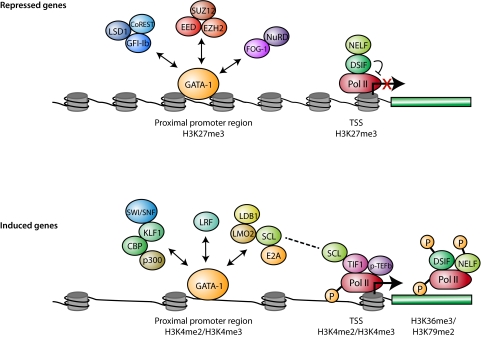Figure 2.
Transcription factors, Pol II status, and histone modifications associated with actively transcribed and repressed genes in erythroid cells. For genes activated during differentiation (bottom panel), the GATA-1 activation-associated proteins exist in different complexes (as indicated by the double arrows) through binding to both distal regulatory regions and promoter regions near the TSS. H3K4me2 and H3K4me3 are enriched in some of these bound regions. TIF-1 and the SCL complex recruit pTEF-b to promote Pol II elongation by phosphorylating DSIF, NELF, and Pol II. SCF could be the link between the GATA-1 complex and Pol II elongation machinery. H3K79me2 and H3K36me3 are often enriched in the transcribed portion of the gene. Among repressed genes (top panel), the GATA-1 repressor complexes are less clear and could exist in different forms as indicated by the double arrows. H3K27me3 is enriched near the TSS. Pol II is either not bound or is paused around the TSS. In the absence of TIF-1, recruitment of p-TEFb is impaired, and DSIF and NELF inhibit the phosphorylation of Pol II and Pol II elongation.

